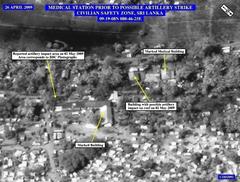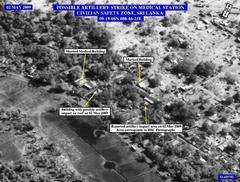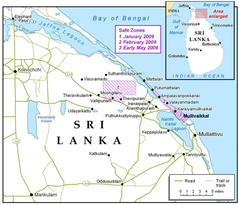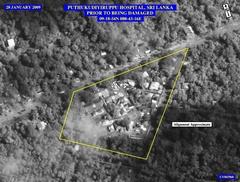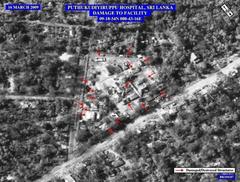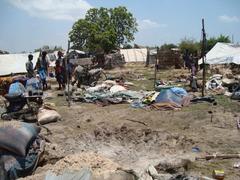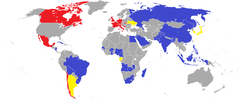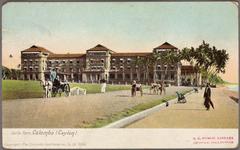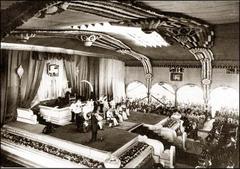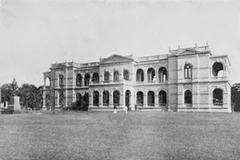
Sri Lankan Civil War Sites in Colombo District: Visiting Hours, Tickets, and Historical Information
Date: 14/06/2025
Introduction: Colombo’s Civil War Legacy and Its Enduring Significance
Colombo, Sri Lanka’s dynamic capital, is more than a bustling metropolis; it is a city deeply shaped by the legacies of the Sri Lankan Civil War (1983–2009). While the war’s frontlines were primarily in the Northern and Eastern Provinces, Colombo played a pivotal role as the administrative, economic, and symbolic heart of the nation. The capital witnessed key events—from the outbreak of Black July riots to high-profile attacks and acts of reconciliation—making it essential for anyone seeking a nuanced understanding of Sri Lanka’s modern history.
Colombo’s war-related sites, from the solemn National War Memorial to the evocative exhibits at the Colombo National Museum, offer profound insights into the causes, costs, and aftermath of the conflict. These sites, along with vibrant spaces like Gangaramaya Temple and Pettah Market, embody both the scars of war and the city’s resilience, diversity, and journey towards reconciliation (World Bank socio-economic report).
This comprehensive guide equips visitors with detailed information on the most significant civil war landmarks in Colombo—including visiting hours, ticket prices, accessibility, cultural etiquette, and travel tips. For a richer experience, many sites offer guided tours and interactive resources, including digital content via platforms like the Audiala app (Audiala app and Colombo Civil War Legacy). Whether you are a history enthusiast, a cultural traveler, or simply interested in Sri Lanka’s journey toward peace, this guide will help you engage thoughtfully with Colombo’s civil war legacy.
Table of Contents
- Introduction: Colombo’s Civil War Legacy and Its Enduring Significance
- Historical Context: Ethnic Tensions and the Outbreak of Conflict
- Major Civil War Milestones in Colombo
- Visiting Colombo’s Key Civil War Sites
- Practical Visitor Information
- Cultural and Social Significance
- Frequently Asked Questions (FAQ)
- Conclusion and Recommendations
- References and Further Reading
1. Historical Context: Ethnic Tensions and the Outbreak of Conflict
The Sri Lankan Civil War’s origins trace back to colonial-era policies and longstanding ethnic tensions between the Sinhalese majority and Tamil minority. During British rule (1815–1948), administrative favoritism, the introduction of Tamil laborers, and the establishment of English-language schools in Tamil-majority areas created enduring social imbalances. Post-independence policies, such as the Sinhala Only Act of 1956, further exacerbated divisions and set the stage for decades of unrest.
By the 1970s, the rise of the Liberation Tigers of Tamil Eelam (LTTE) and demands for an independent Tamil state led to open conflict. The war’s official outbreak, marked by the Black July riots in 1983, began in Colombo and other urban centers and resulted in mass displacement, violence, and a protracted struggle that would last 26 years (World Bank).
2. Major Civil War Milestones in Colombo
Black July (1983)
A defining moment in Sri Lanka’s modern history, the Black July riots erupted after the killing of 13 soldiers by the LTTE. For several days, Colombo witnessed harrowing anti-Tamil violence, resulting in hundreds of deaths, the displacement of thousands, and widespread destruction of property. This event significantly deepened the conflict and led to mass migration of Tamils from the city and country (World Bank).
Urban Terrorism and Security Measures
Throughout the war, Colombo was repeatedly targeted by LTTE bombings, assassinations, and attacks—most notably the 1996 Central Bank bombing and the 1999 bombing campaign. These incidents led to heightened security measures across the city, shaping daily life and public consciousness.
3. Visiting Colombo’s Key Civil War Sites
National Museum of Colombo
The National Museum of Colombo is the country’s premier historical museum and features dedicated exhibits on the civil war. Artifacts, documents, and multimedia presentations explore the roots of the conflict, ethnic tensions, and the reconciliation process.
- Visiting Hours: Daily, 9:00 AM – 5:00 PM (closed public holidays)
- Tickets: Approx. LKR 1,500 for foreigners; discounts for locals
- Accessibility: Wheelchair accessible; guided tours available
Allow at least two hours to fully explore the museum’s collections. The museum is located near Viharamahadevi Park.
Independence Memorial Hall
The Independence Memorial Hall honors Sri Lanka’s 1948 independence and is a key site for official civil war commemorations and remembrance events.
- Visiting Hours: Daily, 8:00 AM – 6:00 PM
- Tickets: Free entry
- Accessibility: Open-air structure; accessible pathways
The hall has hosted numerous rallies, peace events, and state ceremonies related to the conflict.
National War Memorial
Located in Independence Square, the National War Memorial is dedicated to all who lost their lives in the civil war.
- Visiting Hours: Daily, 8:00 AM – 6:00 PM
- Tickets: Free entry
This solemn space is ideal for reflection and is often used for commemorative ceremonies.
Cenotaph War Memorial
The Cenotaph War Memorial honors soldiers from the World Wars and has expanded to include victims of the civil war.
- Visiting Hours: Daylight hours (recommended 6:00 AM – 6:00 PM)
- Tickets: Free entry
- Accessibility: Wheelchair accessible
The memorial is near Viharamahadevi Park and hosts annual remembrance events.
Gangaramaya Temple
The Gangaramaya Temple, a prominent Buddhist temple, played a role in promoting interfaith dialogue and reconciliation during and after the war.
- Visiting Hours: Daily, 7:00 AM – 7:00 PM
- Tickets: Small donation (approx. LKR 300)
- Accessibility: Some sections may be less accessible for wheelchairs; assistance available
The temple’s museum contains artifacts related to the civil war’s impact on religious communities. Modest dress is required.
Viharamahadevi Park
Viharamahadevi Park, the city’s largest public park, was a venue for protests, peace rallies, and activism during the civil war.
- Visiting Hours: Daily, 5:00 AM – 6:00 PM
- Tickets: Free entry
- Accessibility: Wheelchair accessible
The park remains a vibrant community space for events and gatherings.
Pettah Market
Pettah Market is an iconic marketplace reflecting Colombo’s ethnic diversity, which endured both tension and resilience during the conflict.
- Visiting Hours: Daily, 6:00 AM – 6:00 PM (mornings busiest)
- Tickets: Free entry
- Accessibility: Crowded, narrow lanes; limited wheelchair access
It’s a vivid example of everyday life and coexistence amid adversity.
Other Civil War Memorials and Murals
Scattered throughout Colombo, smaller memorials and murals commemorate victims of the civil war. Many are grassroots or community-led and are best appreciated with local guides who can provide context and interpretation.
4. Practical Visitor Information
Getting Around:
Colombo is well-connected by taxis, tuk-tuks, and ride-sharing apps. Public buses are available but may be crowded.
Best Time to Visit:
The dry season (November to April) offers the most pleasant weather for exploring outdoor sites.
Accessibility:
Most major museums and memorials are wheelchair accessible, although some sites, such as Pettah Market, may be challenging.
Photography:
Always seek permission before photographing individuals or sensitive locations, especially at religious or commemorative sites.
Safety and Security:
Colombo is generally safe, but be vigilant in crowded areas and during public events. Security checks are common at major landmarks.
Cultural Etiquette:
Dress modestly, particularly when visiting temples and memorials. Remove footwear where required and maintain respectful behavior.
Guided Tours:
Hiring a local guide or joining an organized tour is recommended for deeper historical context and cultural sensitivity.
Visitor Resources:
Interactive maps, virtual tours, and multimedia resources are available via official museum websites, visitor centers, and the Audiala app (Audiala app and Colombo Civil War Legacy).
5. Cultural and Social Significance
Ethnic and Religious Diversity
Colombo’s diverse communities—Sinhalese, Tamils, Muslims, Burghers, and others—shaped the city’s experience during the civil war. Today, religious and cultural landmarks stand as reminders of both division and coexistence, hosting major festivals like Vesak, Deepavali, and Ramadan (Rough Guides Colombo).
Memory, Memorialization, and Reconciliation
State-sponsored memorials, such as those at Independence Memorial Hall, focus on military sacrifice, while public commemoration of Tamil victims is more limited and often private (Colombo Telegraph). Grassroots memorials and interfaith initiatives promote broader remembrance and healing.
War Tourism and the Politics of Memory
War tourism in Colombo has grown, with state and independent tours offering differing perspectives. Engaging with multiple narratives helps foster a deeper, more inclusive understanding of the city’s past (DW News on Sri Lanka Tourism).
6. Frequently Asked Questions (FAQ)
Q: Are tickets required for all civil war sites?
A: Most memorials and public parks are free. The National Museum of Colombo charges an entry fee, and Gangaramaya Temple requests a small donation.
Q: When is the best time to visit these sites?
A: Early morning visits are less crowded. Outdoor memorials are best visited during daylight.
Q: Are guided tours available?
A: Yes, major sites and private operators offer English, Sinhala, and Tamil tours focusing on the civil war and cultural history.
Q: Are these sites suitable for families?
A: Yes, most sites are family-friendly, and museums often have educational programs.
Q: How can I respect local customs?
A: Dress modestly, ask before photographing, and behave respectfully during ceremonies or in religious spaces.
7. Conclusion and Recommendations
Visiting Colombo’s civil war sites is a powerful way to engage with Sri Lanka’s complex history, from colonial legacies and ethnic tensions to the realities of conflict and the ongoing pursuit of reconciliation. Landmarks such as the Independence Memorial Hall, National Museum, and Gangaramaya Temple serve as spaces for remembrance, reflection, and education.
Travelers are encouraged to approach these sites with sensitivity, recognizing the diverse experiences and ongoing challenges of memory and healing. Utilizing guided tours or digital resources like the Audiala app will enrich your visit, offering deeper context and facilitating respectful engagement with local communities.
By exploring these sites, you contribute to a culture of remembrance and understanding critical for Sri Lanka’s continued journey towards peace and unity.
8. References and Further Reading
- World Bank socio-economic report
- Audiala app and Colombo Civil War Legacy
- National Museum of Colombo
- Colombo Telegraph
- DW News on Sri Lanka Tourism
- Rough Guides Colombo
- Sri Lanka Getaway Visitor Tips
- Trawell.in Colombo Attractions
- Cenotaph War Memorial
- Gangaramaya Temple
- Colombo Pettah Market
- Colombo Municipal Council


